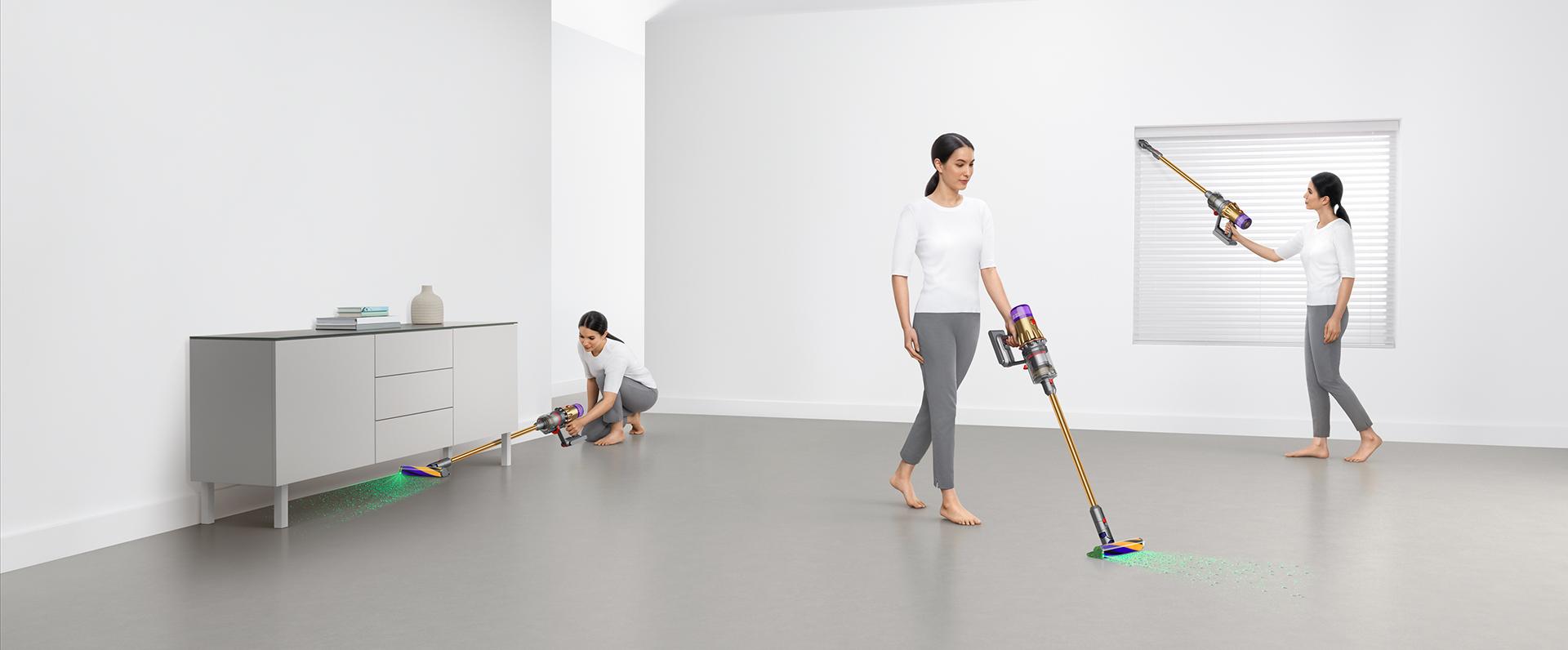
The Dyson whole home cleaning schedule
A weekly cleaning schedule ensures your home stays healthy for all inhabitants. See how to keep the house clean with Dyson's step-by-step guide to each space.
3rd January 2023
Much of the dust and debris in our homes is invisible, yet one in three people only clean when visible dust builds up. As Monika Stuczen – Research Scientist in Microbiology at Dyson reveals, “many dust particles are microscopic in size… by the time people spot visible dust in the home, it is highly likely that there are dust mites in your home”.
A weekly cleaning schedule can help to combat this. It doesn’t need to be daunting either – knowing how to keep the house clean is straightforward with the right tools and tips. To help you keep every space spotless and safe, Dyson’s step-by-step house cleaning schedule covers each room. See how to clean bedrooms and other high traffic areas ahead.
How to create a weekly cleaning schedule
Dyson’s range of vacuums provide solutions to every unique space – whether they be hardwood floors, carpeted, large or compact. By tailoring your cleaning tools to your home, you can ensure a clean bedroom, kitchen and living room. Whether your space suits the hard floor Dyson Omni-glide™ vacuum or extra-large Dyson Outsize™ vacuum, all of our vacuum tools come with helpful accessories. To cut down on cleaning time, it helps to get everything ready beforehand. Our top three preparation tips include:
- Gather the supplies and accessories you’ll need before you begin.
- Work on one area of the house or room at a time, always moving from top to bottom so that all dust is caught.
- Clear any clutter from the floor or other surfaces before beginning your clean.
Step-by-step house cleaning schedule
A good weekly cleaning schedule covers both high traffic rooms as well as neglected areas. Debris, dust and the microbiome that live on them can become airborne and travel throughout spaces, so it’s important to consider the whole home and not just the most visible areas. You may prefer to tackle two unique spaces a week or create a whole home cleaning schedule. See how to clean the house according to space and the necessary tools you’ll need.
How to clean your staircase
Tools you’ll need:
- A cordless vacuum cleaner
- Crevice tool
- Hair screw tool
- A damp, lukewarm cloth
An especially fiddly area, staircases are highly angular and can have both hard floors or carpet coverings. How to clean carpet on stairs requires more versatile tools than rugs.
How to clean staircases:
- Put your vacuum in handheld mode and attach the Crevice tool to it. Always begin at the top of the staircase in order to catch dust which falls as you clean.
- Start by focusing on the edges of each step, moving all the way down. Any loosened debris will be captured in the second move through.
- Once you’ve reached the bottom of the staircase, replace the Flexi crevice tool with the Hair screw tool (continuing in handheld mode). Return to the top and vacuum over the tread of stairs.
- Finish by running a damp, lukewarm cloth down the handrail or banister. To address germs and pollutants, apply a disinfectant before wiping.
How to clean bedroom spaces
Tools you’ll need:
- A cordless vacuum cleaner
- Mattress tool or Hair screw tool
- Light pipe crevice tool
- Low reach adaptor
- Mini soft dusting brush
- A dry rag & damp, lukewarm cloth
Bedrooms – and especially mattresses – are breeding grounds for dust mites. Their faeces are a main source of allergens in the home, and in some cases can trigger asthma. Ensuring a proper clean will benefit the healthy quality of your home.
How to clean bedrooms:
- Starting up-top, use the Mini soft dusting brush attachment to remove dust from curtains, blinds, lampshades.
- Using the Light pipe crevice tool, capture dust around window sills, framed art and furniture. The LED light allows you to see dust behind large pieces of furniture.
- Attach the Mattress tool or Hair screw tool next and go over both sides of your mattress. Sheets and blankets should be washed on high heat where possible.
- Remove excess dust from drawers and bedside tables before wiping down with a cloth dipped in warm water.
- Using the vacuum now, go over the floor space. Any fallen dust will be caught here. The Low reach adaptor can be used to go underneath low furniture.
How to clean the house living area
Tools you’ll need:
- A cordless vacuum cleaner
- Scratch free soft dusting brush
- Light pipe crevice tool
- Low reach adaptor
- Hair screw tool
- A dry rag & damp, lukewarm cloth
Living rooms are often where most time is spent. Especially if there are pets, communal spaces should feature in a weekly cleaning schedule. In households with large open spaces, a larger cleaner head and bigger bin can reduce cleaning time.
How to clean the house living area:
- With the Scratch free soft dusting brush, gently go over delicate surfaces such as the TV.
- Next, pull large furniture like bookshelves, cabinets, chairs and sofas from the wall. With the Light pipe crevice tool, vacuum the skirting boards behind and where the floor meets the wall.
- Living room upholstery and pet beds are home to the food source of dust mites. The Hair screw tool is perfect for these areas – as its anti-tangle brush bar easily collects long hair and removes it to the bin.
- Tend to any furniture with a dry rag and then damp, before vacuuming the floor. The Low-reach adaptor bends to reach further under low furniture.
How to clean the kitchen
Tools you’ll need:
- A cordless vacuum cleaner
- Up-top adaptor
- Awkward gap tool
- Disinfectant, cloth with warm water
Kitchens are the source of a lot of activity, and invariably, mess. Typically hard floored, always mop after vacuuming. This will help to protect your machine.
How to clean your kitchen:
- Start by wiping down surfaces with cleaning products. Stove tops, the area around stoves, pantries, and inside microwaves and fridges should all feature in a house cleaning schedule.
- Next, use the Up-top adaptor and Mini soft dusting brush to vacuum the tops of fridges, cupboards and out-of-reach areas. The soft bristles help to protect materials as you clean.
- Use the Awkward gap tool to access the hard-to-reach places such as down the side of the fridge, collecting food debris and dust build ups.
House cleaning schedule for walls & ceilings
Tools you’ll need:
- A cordless vacuum cleaner
- Scratch free dusting brush
- Flexi crevice tool
- Extension hose
Walls and ceilings are often left out of weekly cleaning schedules, but dust left on this area can contribute to mould growth if left to accumulate. Cobwebs, dust and organic matter all settle here – fortunately, cleaning the area is quick and easy with the right tools.
- Start with the ceilings. Using the Scratch free dusting brush to protect paint, go over the area. The Flexi crevice tool can be used in the hard-to-reach or narrow spaces.
- The HEPA filter in the Dyson Gen5detect™ vacuum captures tiny particles down to 0.1 microns1. The Extension hose and scratch-free Dusting brush attachments adds 61cm for flexible reach.
Loved this guide? Keep reading to for tips on comprehensive carpet cleaning.
1Filtration tested against ASTM F3150, tested in Boost mode by independent third-party, SGS-IBR Laboratories US in 2022. Filtration efficiency is calculated by comparing the number of standardised dust particles entering the vacuum cleaner against those released. The capture rate may differ depending on actual environment and the mode.
Press Contact
ANZ Press Office
Email: aupressoffice@dyson.com
Dyson Newsroom
 Call us
Call us Email us
Email us Request a meeting
Request a meeting Live chat
Live chat